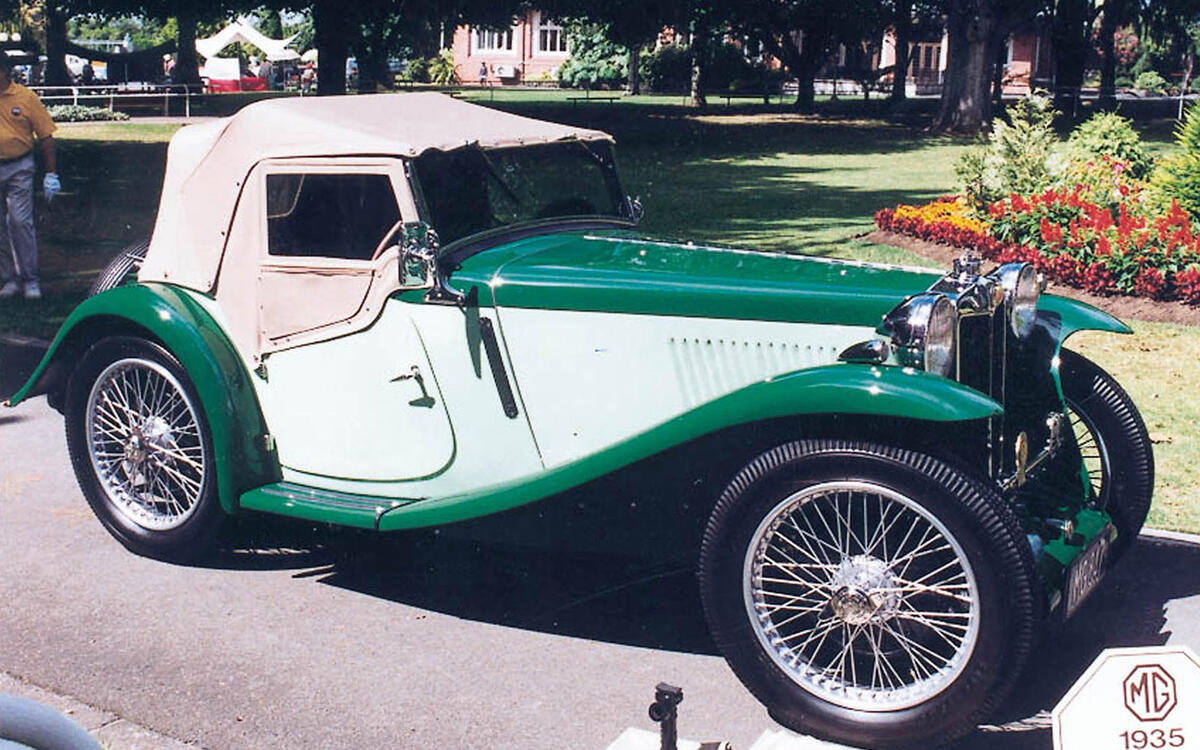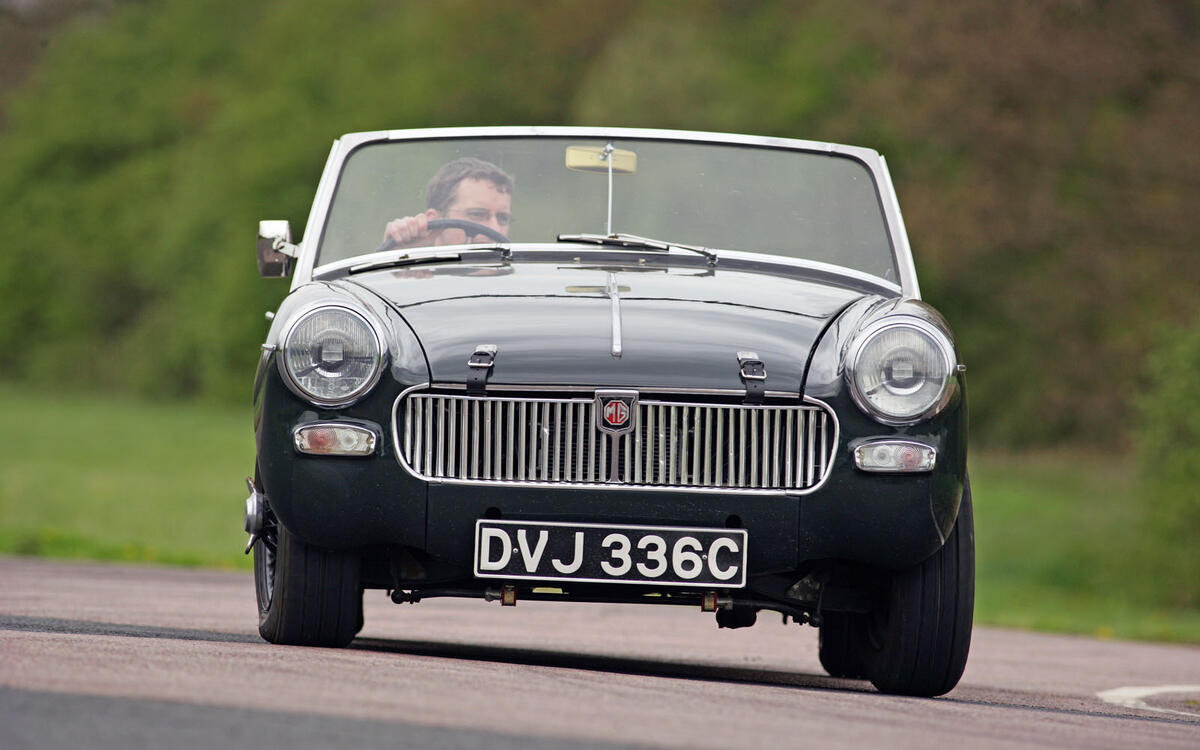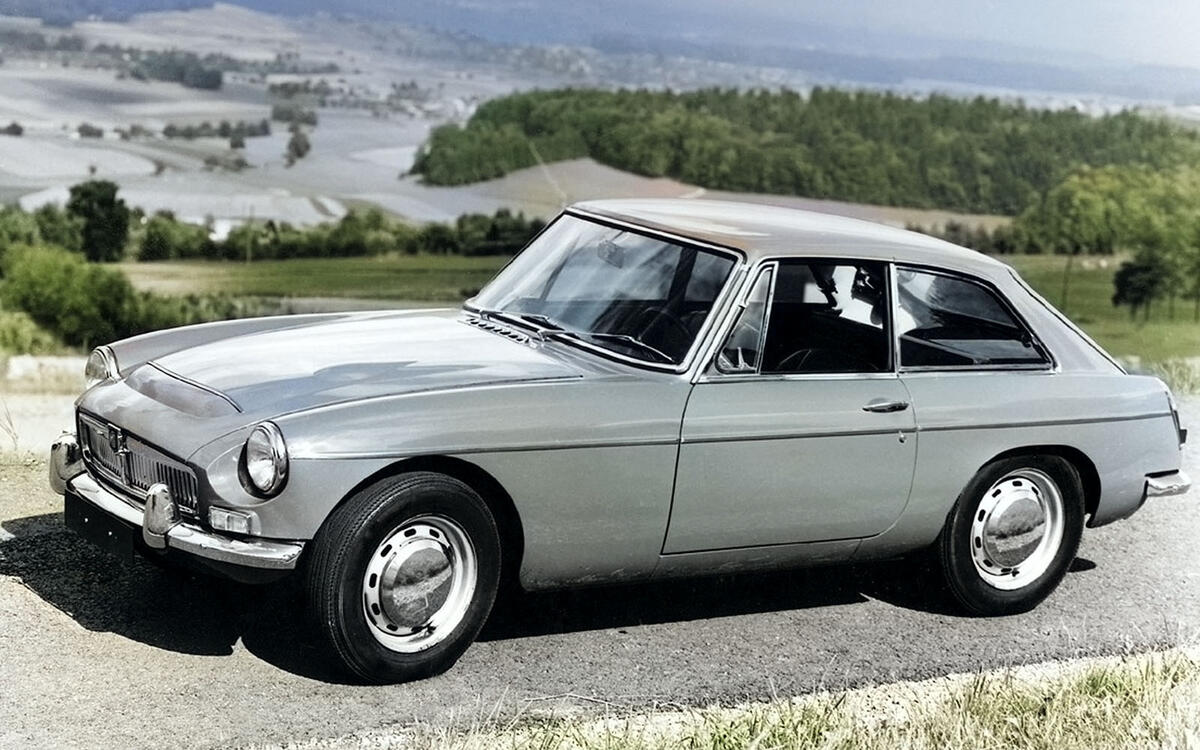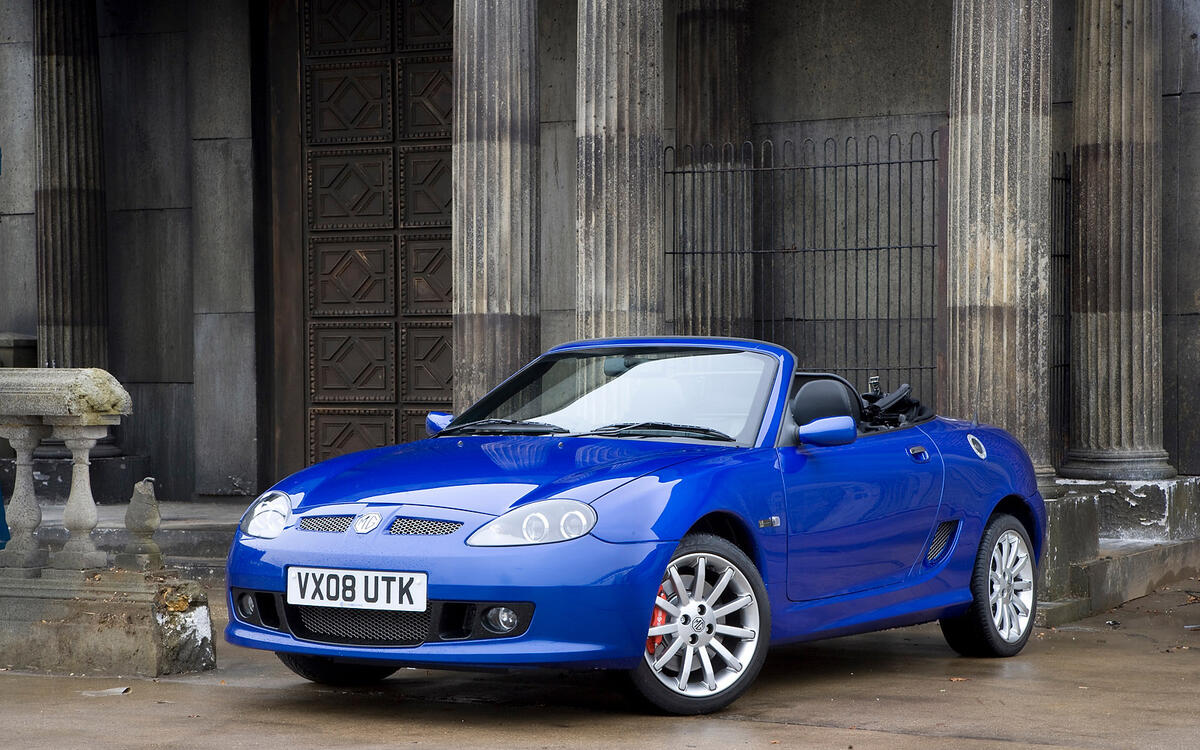 Slide of
Slide of
MG is celebrating its centenary in 2023.
So wer'e going to look at its best cars. We’re focusing on sports cars, predominantly from the post-war period, so don’t be too disappointed by the absence of some of the badge-engineered saloons and the like. Seatbelts on:
 Slide of
Slide of
Old Number One
Although there had previously been cars modified to MG spec, Old Number One was the first car to wear an MG badge. It was designed by Cecil Kimber to do one thing: win races. The car was first seen at the 1925 Land’s End Trial and was based on a bullnose Morris Cowley chassis. It wasn’t the first MG, but it was the company’s first car built for sporting purposes.
 Slide of
Slide of
MG M-Type Midget
The importance of this MG cannot be underestimated. Launched in 1929, it was based on the Morris Minor and used a Wolseley-designed overhead-cam engine, and some 3235 were built from 1928 until 1932. We said: “Sixty or sixty-five miles an hour are not adventure but delight; acceleration is very brisk – altogether an extraordinarily fascinating little vehicle.” In 1931, with modifications, including a four-speed gearbox, it became the first 750cc car to hit 100mph.
 Slide of
Slide of
MG P-Type
Skipping forward to 1934, MG launched the P-Type as a replacement for the J2, with the company claiming that it boasted ‘over 100 new and improved features’ over its predecessor. We agreed, saying: “This latest model is a marked improvement in all respects over its forerunners’. Dubbed ‘The World’s Finest Competition Car’ by MG, the PA was powered by an 847cc engine before the more powerful 939cc PB arrived in 1935.
 Slide of
Slide of
MG TA
The T-Type lineage began in 1936 with the TA and wouldn’t end until the MGA replaced the TF in 1955. Longer and wider than the P-Type, the TA was roomier and more comfortable, with power sourced from a Morris-sourced 1292cc four-cylinder engine producing 50bhp. This was enough to propel the TA to a top speed of 79mph, and 3003 were built before it made way for the TB.
 Slide of
Slide of
MG TB
Although it looked similar to the TA, the TB arrived in 1939 with centre-laced wire wheels, semaphore-type indicators and redesigned cooling louvres on the bonnet side panels. MG purists welcomed the TB with open arms, not least for its new 1250cc XPAG engine, which was both highly tuneable and more reliable than the TA’s motor. Unfortunately, just 379 cars were built before the outbreak of the Second World War.
 Slide of
Slide of
MG TC
With the end of the war, MG put the T-Type back into production as the TC. Although it was essentially a wider version of the TB with rubber bush shackles rather than sliding trunnion spring mountings, the TC was faster, thanks to the XPAG engine with twin carburettors and a four-speed gearbox with synchromesh on all forward gears. Despite being right-hand drive only, the TC was the first MG to be exported to the US, which helped production to reach 10,000 units.
 Slide of
Slide of
MG TD
With 29,664 cars produced, the TD was the most popular of all the T-Type MGs. Launched in 1949, it was the first significant restyling since the TA of 1936, but not everything was well received. The switch from wire to disc wheels was the most controversial change, even though they were easier to keep clean and less susceptible to buckling on Britain’s pockmarked roads.
 Slide of
Slide of
MG TF
Unveiled in 1953, the TF was essentially a stopgap while MG prepared to put the MGA into production. The faired-in headlights gave it a more modern look, but the T-Type was starting to look dated alongside rivals from Triumph and Austin-Healey. That said, Road & Track named it ‘America’s best sports car buy’ but noted that it struggled to compete in a market dominated by V8 muscle. A total of 9600 TF 1250 and 1500 models were built before production ended in 1955.
 Slide of
Slide of
MGA
The launch of the MGA in 1955 couldn’t come soon enough. Two decades separated it from the TA, but from a styling perspective, the two cars could have been lightyears apart. Underneath, the MGA utilised a development of the 1489cc engine from the ZA Magnette saloon, with drum brakes, independent front suspension, rack-and-pinion steering and a four-speed gearbox. Just a year after its arrival, the MGA roadster was joined by a coupé, before the engine was enlarged to 1588cc and 1622cc in 1959 and 1961 respectively.
 Slide of
Slide of
MGA Twin-Cam
The fastest of the MGA models, the Twin-Cam featured a 1588cc twin overhead cam engine producing 108bhp. As a result, it could hit 60mph in a respectable 9.1sec before hitting a top speed of 113mph, although reliability problems blighted its reputation. This, combined with strong competition from the likes of the Triumph TR3A and Austin-Healey 100/6, meant that sales limped to just 2111 between 1958 and 1960. Pace and rarity make it the most valuable MGA in 2023.
 Slide of
Slide of
MG Midget
The Midget began life as a badge-engineered version of the Austin-Healey ‘Frogeye’ Sprite, but ended up outlasting its sibling by nearly a decade. A policy of continuous development kept it alive throughout the 1960s and ’70s, with production ending in 1979 after 224,843 had been built. The fitment of Triumph’s 1493cc engine in 1974 was designed to satisfy US emissions regulations and some 73,889 were produced.
 Slide of
Slide of
MGB roadster
The B is probably the first car people think of when you mention MG sports cars. It’s arguably the definitive British roadster and was, until the arrival of the Mazda MX-5, the most popular sports car of all time. Although the suspension was based on the MGA’s to keep development costs in check, the MGB was powered by an upgraded 1798cc B-Series engine producing 96bhp, with a price tag that undercut both the Triumph TR4 and Sunbeam Alpine.
 Slide of
Slide of
MGB GT
Three years after the launch of the roadster, the MGB GT was unveiled at the 1965 Earls Court Motor Show. Although styled by Pininfarina, the GT bore a striking resemblance to the MGB Berlinette, a limited-run coupé designed and built in Belgium. Sir Alec Issigonis told the designer Jacques Coune that it looked “too Italian”. The MGB GT was hugely successful, accounting for 125,282 of the 513,276 MGBs built.
 Slide of
Slide of
MGB GT V8
The GT V8 was the brainchild of Mini racer Ken Costello, who identified the opportunity to squeeze an ex-Buick Rover 3.5-litre V8 into the MGB’s engine bay. Unlike the MGC, which was undone by the weighty 3.0-litre straight-six it shared with the Austin 3-Litre, the GT V8 benefited from an alloy engine that was of similar weight to the 1800cc unit. It was undone by the fuel crisis, so just 2591 were ever built.
 Slide of
Slide of
MGC
Launched in 1967 in roadster and GT forms, the MGC was one of Abingdon’s most controversial cars. While it was accepted that the MGB could handle more power, the MGC was weighed down by the 3.0-litre straight-six engine, which made the car nose-heavy while upsetting the B’s sweet handling. Fine as a grand tourer, sales limped to around 9000, shared equally between the two body styles, before production ended in 1969.
 Slide of
Slide of
MG RV8
We love the MG versions of the Metro, Maestro and Montego, but they weren’t proper MG sports cars. Arriving a couple of years before the MGF, the RV8 was essentially a remastered MGB, featuring a body by British Motor Heritage, a 3.9-litre Rover V8 producing 185bhp and updated suspension. Around 1500 of the 1983 cars built were exported to Japan following its launch at the 1993 Tokyo motor show.
 Slide of
Slide of
MG F
Although often unfairly overshadowed by the Mazda MX-5, the MG F arrived in 1995 to critical acclaim. Launched with a 1.8-litre K-Series engine producing 120bhp or 145bhp, the F featured Hydragas suspension and a five-speed gearbox. Its mid-engined layout delivered excellent handling, while the Hydragas delivered the kind of ride quality not normally associated with a sports car. A total of 77,269 Fs were built before production ended in 2002.
 Slide of
Slide of
MG TF
The TF was another success story for MG, becoming one the UK’s best-selling sports. Nearly 40,000 were built before MG Rover’s demise in 2005, cutting short its potential to outsell its predecessor. New aerodynamics set it apart from the MG F, as did the steel spring suspension, which gave it a harder edge than before. In 2008, the TF made an unlikely comeback as the MG TF LE 500 following the NAC’s purchase of MG Rover’s remaining assets.
 Slide of
Slide of
MG XPower SV and SVR
MG was in the midst of crisis when it launched the SV as a halo model for the rest of the range. The car started life as the De Tomaso Bigua, then the Qvale Mangusta, before being restyled by Peter Stevens as an MG. Built in Italy, the SV was then shipped to the UK for finishing, with a choice of two V8 engines available: a 4.6-litre in the SV and a 5.0-litre in the SVR. Just 82 cars were reportedly built; 19 remain on the UK road, with another 23 off-it on a SORN.
 Slide of
Slide of
MG Cyberster
It’s too early to predict the success, or otherwise, of the MG Cyberster, but it’s likely to arrive in the first half of 2024. Details are sketchy, but the Cyberster will be all-electric and available in rear- and all-wheel drive versions. The company says it was given the green light for production after it received more than 5000 expressions of interest, which bodes well for the future of MG sports cars. With the MG badge been mostly placed on family saloons and SUVs, the brand is going back to the future.
Access control:
Open












































